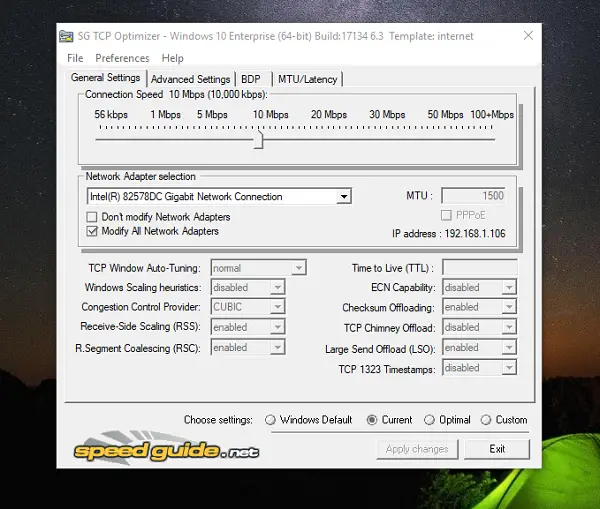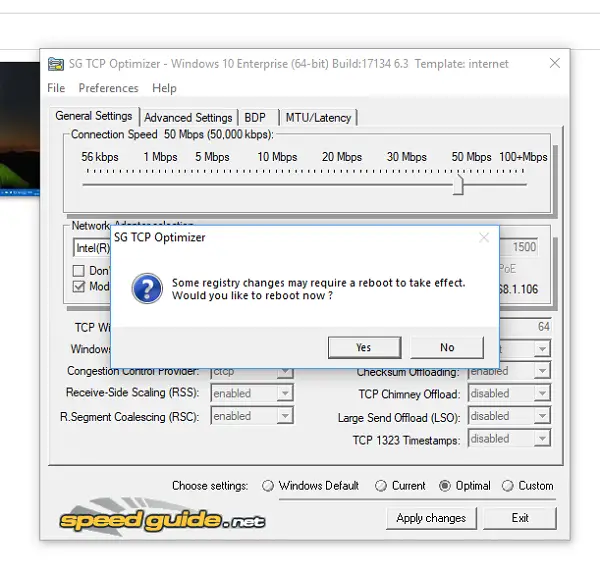TCP is the de-facto transport protocol on the Internet. It makes sure to send, and receive information across the internet for every type of content. It’s everywhere. When you load a website or send an email or watch a movie on YouTube. Today, it is one of the core protocols of the Internet Protocol (IP). It is also responsible to make sure to manage data sent in a way, that there is no congestion anywhere. That said, TCP/IP can be optimized even further. In this post, we are sharing how to analyze and optimize TCP/IP with TCP Optimizer. It’s a software that can optimize TCP/IP.
Analyze & Optimize TCP/IP with TCP Optimizer
There are two parts. The first is Analysis, and the second is Optimization. You can analyze by visiting this link on their website. The analysis displays a bunch of messages which you might not totally understand except for bits, and pieces. The basic idea one can easily understand is there are a few settings for TCP which can be changed so more data can be sent across. The default settings restrict the amount of data. You will get details about MTU, MSS, RWIN, and so on. What you should look is if there is anything which suggests you change values, and optimizes TCP.
I got the following messages:
- MTU is optimized for PPPoE DSL broadband. If not, consider raising MTU to 1500 for optimal throughput.
- MSS is optimized for PPPoE DSL broadband. If not, consider raising your MTU value.
- RWIN is not fully optimized. The unscaled RWIN value is lower than it should be. You might want to use one of the recommended RWIN values below.
Keep this page open, as you will need it for optimizing the TCP on your PC using their software.
How to optimize TCP/IP
TCP Optimizer is a portable software which changes few things on the network level, and few on registry settings. The best part is that its a portable application of a very small size. Suggest you keep a copy in your Inbox. Once you download it from here, launch it with admin privileges.
- Once launched, it will run a bunch of commands which helps it to get the settings on your PC.
- The first thing you should do is select the right internet speed using the slider on the software.
- Next, look at the analysis you got above, and see what values you can change. If you are not comfortable, you can skip it.
- There are four options:

- Default — Anytime you want to fall back to original settings, choose this.
- Current — Current settings
- Optimal — Safest method which lets the software choose the best for you.
- Custom — Use this if you know this clearly. In my case, I changed the MTU value to 1500 and also optimized RWN value.
Those who are wondering how it chooses the optimal settings, then its because of the advanced algorithm in the software. Depending on PC to PC, and network, it finds the best TCP Settings for your specific connection speed.

For those who understand technical details, it tunes TCP/IP parameters, such as MTU, RWIN, and even advanced ones like QoS and ToS/Diffserv prioritization. While the application is mostly for broadband uses, you can use it on almost any connection.
Features of TCP Optimizer:
- If your PC has multiple network adapters, you can optimize each of them.
- Restore / Backup settings.
- Direct option to reset TCP/IP and WINSOCK.
- Under the custom option, you can choose different types of optimization including disabled, highly restricted, normal, restricted and experimental.
- You can always switch back to the default Windows settings.
- Check MTU/Latency.
After it applies new settings, it will ask you to reboot the PC for the best results. I will always suggest keeping an eye on your internet browsing performance and making sure it has either remained the same or has improved. In case there is a problem, choose to roll back to default Windows Settings.
Fun Fact – Windows comes with an Window Auto-Tuning feature which was first released with Windows Vista. It is available in Windows 11/10, and many disable it because of some issues. The primary reason to disable it is when you use an old router and auto-tuning doesn’t go well with it.
Leave a Reply